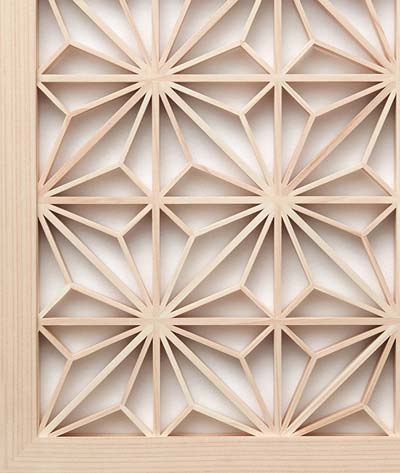Comparison of the patterns of kumiko woodworking
The frame has three types.
30 x 30 mm (Standard), 16 x 16 mm and 12 x 12 mm. If the frame thickness is 12 mm x 12 mm, the price will be 10 percent higher.
Strength level: In respect of strength, Level 5 is the highest, Level 2 is the lowest.
Pattern size: 2 different pattern sizes are available,“ Standard” and“ Large”.
※Seigaiha, Shippo and Fundo cannot be adjusted. The price of large size is 30 % less than the one for a standard size.
Price per 300 x 300 mm size
-

Asanoha
Since ancient times the Asanoha motif has been used in holy rituals. It is a familiar design that is often used for baby clothing as it is believed to bestow health and long life.
-

Goma
Since historical times, the Goma motif was thought to bestow perpetual youth and long life. The pattern is generally favoured by restaurant owners as it augurs well
for the health and longevity of their customers. -

Sakura
The cherry tree is the most popular flowering plant in Japan.
It is a long held belief that the rice deity resides in the cherry tree and that the amount of blossom determines
whether the harvest of a given year will be good or bad. -

Shokko
The Shokko design, based on an octagon, comes from brocade woven in the Shu Dynasty of China.
In China, where eight is the most auspicious number,
the octagonal lattice pattern was used in the Forbidden City, home to the emperors.
As the design conveys the meaning of successful marriage and longevity,
it is used at wedding ceremonies and in hotels -

Sayagata
Sayagata-kuzushi, meaning “unbroken continuity“ is a slightly modified form of the design that represents a wish for household prosperity and longevity.
-

Izutsu
The Izutsu design originates from the square fence surrounding a well. Water being essential for life, the motif signifies protection of our daily lives.
Also, money used to be referred to as a “coin fountain”, and thus wishes for financial and business success are also incorporated in this design. -

Mikado
For having its strongest structure in all other polygons, the triangle has been considered a symbol of power and stability since ancient times.
-

Sanjyubishi
Formed from diamond shapes arranged in three tiers, the design refers to a wish for the prosperity, long life and health of our descendants, so is widely used at wedding ceremonies and in hotels.
-

Senbon
The simple open squares of the lattice are believed to protect against evil.
Many small squares also represent the wish for the health and prosperity of future generations.
Symbolising authority and tradition, lattice designs are widely used in historical structures throughout the world.
The attractive design is to be seen in modern Japanese style houses and Japanese restaurants. -

Masu
Projecting strength and beauty while allowing light and air to pass through, the lattice design is widely used in historical structures.
Many small squares are believed to protect against evil and also represent a wish for the health and prosperity of future generations.
The design suits modern Japanese style houses and Japanese restaurants, as well as traditional structures. -

Seigaiha
Since waves resemble the shape of an open and widening fan, this auspicious design is very popular with the Japanese.
Embodying wishes for financial and business success, the design is suited to being used at Shushi and other Japanese restaurants. -

Shippo
Shippo, or the "seven treasures", as in the Buddhist Scriptures, refers to gold,
silver, lapis lazuli, crystal, agate, red coral, and carnelian.
The treasures are represented by never-ending linked circles and links,
both of which have the same pronunciation in Japanese.
This is considered to be an auspicious design that embodies a wish for family happiness and financial success. -

Kakuasa
The hemp leaf is a traditional Japanese design element that is thought to bring good fortune.
Enclosing the leaf within a square is believed to enhance the stability of good fortune, and the aggregate of triangles denotes protection against evil. -

Rindo
The Gentian expresses the virtues of love, sincerity, justice and tolerance.
As a digestive medicine called Rindo is made from its roots, the purple flower is popular as a symbol of longevity on the Respect-for Senior Citizens Day. -

Kagome
This motif derived from woven bamboo baskets is associated with driving away and protecting against evil and explains why bamboo baskets used to be placed at entranceways.
And it is interesting to note that Kagome motifs are etched on the stone lanterns placed around the Ise Shrine.
The design is often used to drive away evil because it expresses the relationship between sunlight and shadow, light and darkness. -

Mitsukude
The triangle, which is the basis of Kumiko, is a beautiful shape that has universal associations, including with the Greek number Pi, the Pythagorean Theorem and the Egyptian pyramids.
The number three is regarded as an auspicious number in Japan and elsewhere. -

Fundo
As the fundo was used to weigh gold and silver, it symbolises wealth.
The motif has been used for family crests and similar applications.
Fundo-watsunagi is a pattern where weights are linked with wa, or hoops,
the pronunciation of which is the same as the word for peace in Japanese. -

Tsumiishi-kikko
The hexagon, derived from the shape of the segments of the turtle shell,
has long been regarded as an auspicious design motif as it relates to the long life of the turtle - “Turtles live ten thousand years, and cranes one thousand years.”
And so those who protect themselves, as turtles do within their shells, may enjoy longevity and health. Also, as the motif symbolises a banknote, it is thought to bring good fortune.
